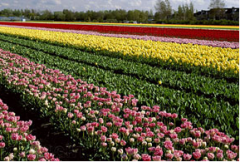Cut flowers and florist plants/greens
| Infobox on Cut flowers and florist plants/greens | |
|---|---|
| Example of Cut flowers and florist plants/greens |  |
| Facts | |
| Origin | - |
| Stowage factor (in m3/t) | - |
| Humidity / moisture | - |
| Ventilation | - |
| Risk factors | - |
Cut flowers and florist plants/greens
Contents
Description / shipment and storage / Risk factors
1.1 Introduction
International trade in flowers and plants is far more extensive than most people imagine. Most people know that The Netherlands play a large role in this trade. In fact, most people think of flowers – especially tulips – when they think of Holland. But tulips are not the only crop grown in Holland. Dutch growers produce an extremely varied selection of floral produce. And variety is to a high degree the foundation of the competitive nature of this sector of the Dutch economy.
Holland has become the world’s largest cut flower and pot plant exporter. But this small country is also the world’s largest consumer of domestic flowers and plants.
How did Holland achieve this prominent position as an exporter? First of all, Dutch agriculturists believe in cooperation. Researchers, training information services, producers and distributors all work together. Agriculture often is held up as an example to other sectors of the nation’s industry.
The degree of cooperation may be stronger in floral trade and production. Especially the cooperative auctions play an important part in floricultural sales. Holland is located near the most important markets, and, via auctions, offers a wide variety of high quality floral products, included imported varieties, all year. The liberal approach of the Dutch toward competition has heightened its impact on the international floral scene. Researchers, producers and exporters do not set out to compete with developments elsewhere in the world but try to use them to their own advantage. Many sectors of Dutch industrial life have been chosen to beat their competitors, rather than join them. This strategy of confrontation is not the style of the floral sector, which has always been characterised by a more liberal attitude. Cooperation is tailored for the advancement of those involved. This cooperation is evident not only in production and research but also in trading. The untrammelled growth of international trade, boosted by the creation of the European Community, has contributed to the rapid development of production and export of flowers and pot plants. The cooperative auctions have seized opportunities presented by these circumstances and a unique situation has come into being. Not only produce of member-producers is auctioned but, in addition, a wide assortment of flowers and pot plants from all parts of the world is siphoned through the system. Especially during the period that unfavourable climate prohibits growing some varieties in Holland. In this way a complete range of floral products is always available from the auctions. This is unique and set floriculture apart from other sectors of the agricultural industry. Export wholesalers are able to supply almost a complete range of products throughout the year, even during the winter. And this is very attractive to customers.
The traditional export market for Holland is neighbouring Germany, as well as other European countries. In recent years there has been healthy growth in trade with distant markets such as the USA, the Middle Eats, and even Japan, Australia and Hong Kong.
The close cooperation that characterises the Dutch floral industry, combined with continual improvement of the sector, justifies the hope that the industry will take an active role in current international developments. The Aalsmeer flower auction occupies a prominent place in the international flower and plant trading.











